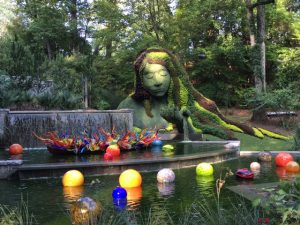
That’s the idea that seems to underlie the exhibitions of art glass by Dale Chihuly that travel to botanical gardens around the world. In September, I saw the latest version at the Atlanta Botanical Garden on a tour as part of the annual conference of the Association of Garden Communicators.
The fantastic and colorful glass sculptures are installed throughout the indoor and outdoor spaces of this great public garden. Some works are placed as focal points, like monumental statues. Others—I think I like them most—appear unexpectedly among the plants, indoors and out, their sinuous, seemingly organic forms echoing the shapes of leaves or contrasting with the natural surroundings.
There’s a special magic when fantastic glass art is installed inside a glasshouse. Conservatory collections are full of tropical and desert plants, with exotic forms that are striking to a visitor used to the North American landscape. Somehow the out-of-this-world shapes of Chihuly’s sculptures fit right in, blurring the line between his imagination and nature’s. The diffuse light, refracted by the glass overhead, enhances the magic.
The first time I saw Chihuly’s art was in the Garfield Park Conservatory in Chicago in 2001. It was the first of his Garden Cycle installations in botanical gardens, and it was a revelation.

Since then I’ve seen two more exhibitions. At the Frederik Meijer Gardens & Sculpture Park in Grand Rapids, Michigan, my greatest memory is of mysterious glass orbs floating in the mist in a wetland along the river, as if they were a native life form I’d never suspected. At Atlanta, I loved the snaky green glass in the conservatory, placed as if it grew there, but I also enjoyed the big blue ball of fireworks in a fountain. Each exhibit is familiar but different, responding to the settings and the local plants. Each one is a new kind of magic.
It makes me feel that sunny conservatories are a natural place to display glass art (if you can hang it or place it where it’s safe from being broken in the course of gardening). l tend to think of home greenhouses as functional spaces, places for seed starting, housing tropicals, or overwintering tender plants. But for many people they’re also living spaces, to relax or entertain. How about a colorful bit of stained glass? How about a chandelier? There’s no fear they will outshine your plants. It’s just another kind of art.


